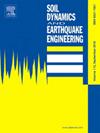Determination of dynamic interaction factors for closely spaced pile groups using spectral element methodology considering soil–pile interaction and weak zone effects
IF 4.2
2区 工程技术
Q1 ENGINEERING, GEOLOGICAL
引用次数: 0
Abstract
This study explores the dynamic response of closely spaced pile groups under horizontal vibrations, emphasizing soil–pile interaction and dynamic interaction factors. A detailed framework is developed to evaluate pile-to-pile interactions, incorporating the propagation of primary and secondary waves. Vibrations from a source pile propagate through the soil, interact with adjacent piles, and generate secondary waves that influence the system’s overall dynamic response. To account for soil property variations caused by pile driving, the soil medium is modeled with an inner field (weak zone) and an outer field. The weak zone, characterized by reduced stiffness, significantly affects soil–pile interaction. Averaging the impedance contributions from both zones enables accurate modeling of the soil between piles, with the spectral element methodology employed to compute group pile impedances. Results show that for a 2 × 2 pile group, increasing the shear modulus ratio () from 0.3 to 1 leads to a 16% rise in stiffness and a 10% increase in damping, while larger 3 × 3 groups exhibit greater damping at lower frequencies. Increasing boundary zone thickness reduces stiffness by up to 20% and raises damping by 40%. Weak zone damping further lowers effective stiffness by up to 20%. These findings provide critical insights into frequency-dependent effects, offering guidance for optimizing pile-supported foundation designs.
考虑土-桩相互作用和薄弱区效应,采用谱元法确定间距较近的桩群的动力相互作用系数
本研究主要研究密集间距桩群在水平振动作用下的动力响应,重点研究土桩相互作用和动力相互作用因素。我们开发了一个详细的框架来评估桩与桩之间的相互作用,包括一次波和二次波的传播。源桩的振动通过土壤传播,与邻近的桩相互作用,并产生影响系统整体动力响应的二次波。为了考虑打桩引起的土体性质变化,将土介质建模为内场(弱区)和外场。软弱区以刚度降低为特征,对桩土相互作用影响显著。平均两个区域的阻抗贡献可以精确地模拟桩间土壤,采用谱元方法计算群桩阻抗。结果表明:对于2 × 2桩群,将剪切模量比(GiGo)从0.3增加到1,刚度增加16%,阻尼增加10%,而较大的3 × 3桩群在低频处阻尼更大;增加边界区厚度可减少高达20%的刚度,并提高40%的阻尼。弱区阻尼进一步降低有效刚度高达20%。这些发现为频率相关效应提供了重要见解,为优化桩支撑基础设计提供了指导。
本文章由计算机程序翻译,如有差异,请以英文原文为准。
求助全文
约1分钟内获得全文
求助全文
来源期刊

Soil Dynamics and Earthquake Engineering
工程技术-地球科学综合
CiteScore
7.50
自引率
15.00%
发文量
446
审稿时长
8 months
期刊介绍:
The journal aims to encourage and enhance the role of mechanics and other disciplines as they relate to earthquake engineering by providing opportunities for the publication of the work of applied mathematicians, engineers and other applied scientists involved in solving problems closely related to the field of earthquake engineering and geotechnical earthquake engineering.
Emphasis is placed on new concepts and techniques, but case histories will also be published if they enhance the presentation and understanding of new technical concepts.
 求助内容:
求助内容: 应助结果提醒方式:
应助结果提醒方式:


